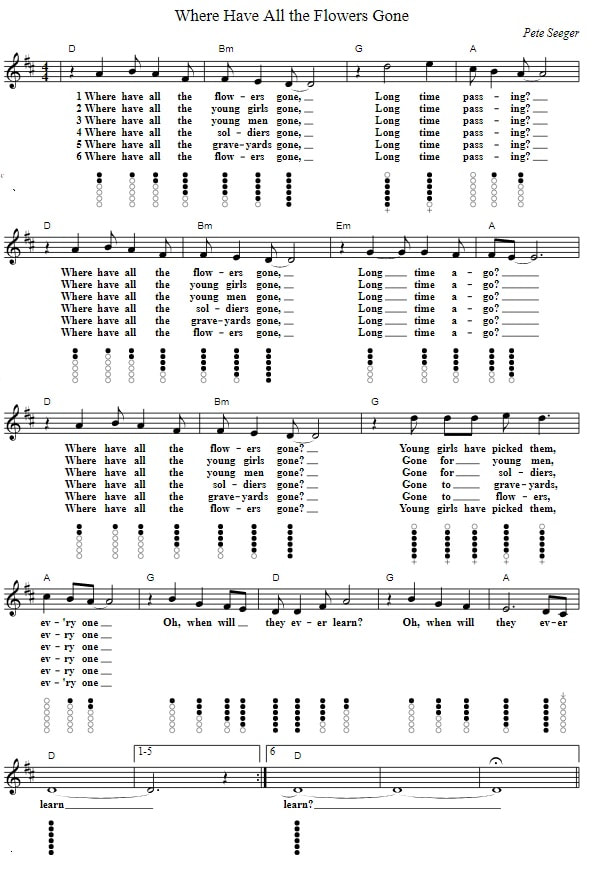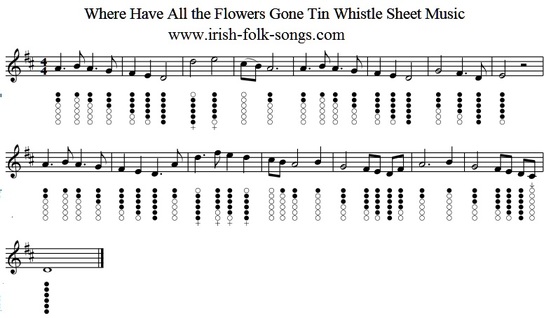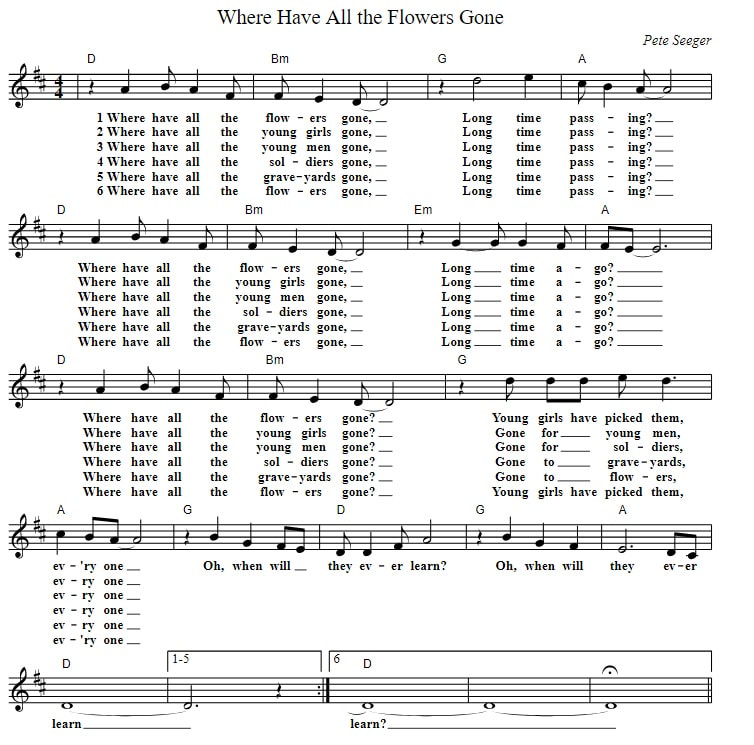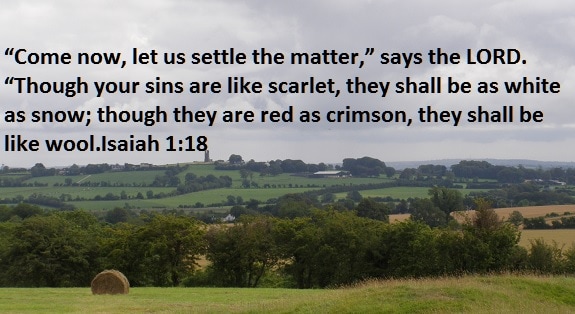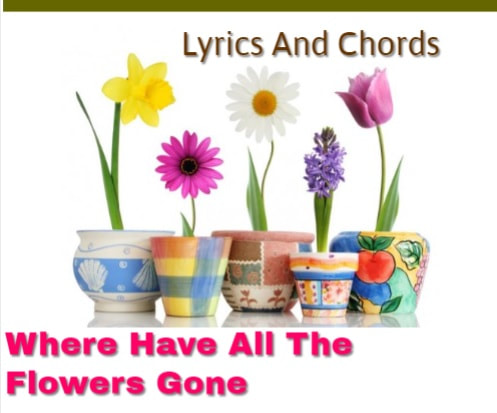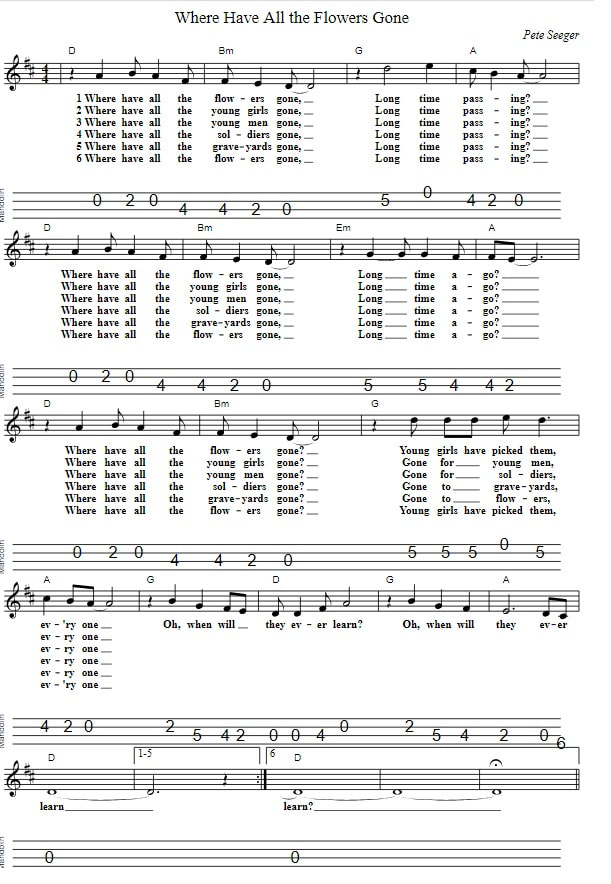Where have all the flowers gone lyrics and chords
The sheet music and tin whistle notes are included. Recorded by Pete Seeger, Peter Paul And Mary, Marlène Dietrich, Joan Baez, The Kingston Trio and The Seekers to name a few. The song was also recorded in Ireland by Tommy Sands and Dolores Keane and I have given a version of the chords they use in the song. Pete Seeger also covered a little favorite of my that I made a youtube video for called Henry My Son Song song.Where have all the flowers gone mandolin and tenor banjo tab with chords in D Major included.
G Em C D
Where have all the flowers gone, long time passing?
G Em C D
Where have all the flowers gone, long time ago?
G Em
Where have all the flowers gone?
C D Am7 D7
Young girls picked them, ev' - ry one.
C C/B G G/F# Em C C/B Am D G
When will they ev - er learn? Oh, when will they ever learn?
G Em C D
Where have all the young girls gone, long time passing?
G Em C D
Where have all the young girls gone, long time ago?
G Em
Where have all the young girls gone?
C D Am7 D7
Gone to the young men, ev' - ry one.
C C/B G G/F# Em C C/B Am D G
When will they ev - er learn? Oh, when will they ever learn?
G Em C D
Where have all the young men gone, long time passing?
G Em C D
Where have all the young men gone, long time ago?
G Em
Where have all the young men gone?
C D Am7 D7
Gone for soldiers, ev' - ry one.
C C/B G G/F# Em C C/B Am D G
When will they ev - er learn? Oh, when will they ever learn?
G Em C D
Where have all the soldiers gone, long time passing?
G Em C D
Where have all the soldiers gone, long time ago?
G Em
Where have all the soldiers gone?
C D Am7 D7
Gone to grave yards, ev' - ry one.
C C/B G G/F# Em C C/B Am D G
When will they ev - er learn? Oh, when will they ever learn?
G Em C D
Where have all the grave yards gone, long time passing?
G Em C D
Where have all the grave yards gone, long time ago?
G Em
Where have all the grave yards gone?
C D Am7 D7
Gone to flowers, ev' - ry one.
C C/B G G/F# Em C C/B Am D G
When will they ev - er learn? Oh, when will they ever learn?
Where have all the flowers gone, long time passing?
G Em C D
Where have all the flowers gone, long time ago?
G Em
Where have all the flowers gone?
C D Am7 D7
Young girls picked them, ev' - ry one.
C C/B G G/F# Em C C/B Am D G
When will they ev - er learn? Oh, when will they ever learn?
G Em C D
Where have all the young girls gone, long time passing?
G Em C D
Where have all the young girls gone, long time ago?
G Em
Where have all the young girls gone?
C D Am7 D7
Gone to the young men, ev' - ry one.
C C/B G G/F# Em C C/B Am D G
When will they ev - er learn? Oh, when will they ever learn?
G Em C D
Where have all the young men gone, long time passing?
G Em C D
Where have all the young men gone, long time ago?
G Em
Where have all the young men gone?
C D Am7 D7
Gone for soldiers, ev' - ry one.
C C/B G G/F# Em C C/B Am D G
When will they ev - er learn? Oh, when will they ever learn?
G Em C D
Where have all the soldiers gone, long time passing?
G Em C D
Where have all the soldiers gone, long time ago?
G Em
Where have all the soldiers gone?
C D Am7 D7
Gone to grave yards, ev' - ry one.
C C/B G G/F# Em C C/B Am D G
When will they ev - er learn? Oh, when will they ever learn?
G Em C D
Where have all the grave yards gone, long time passing?
G Em C D
Where have all the grave yards gone, long time ago?
G Em
Where have all the grave yards gone?
C D Am7 D7
Gone to flowers, ev' - ry one.
C C/B G G/F# Em C C/B Am D G
When will they ev - er learn? Oh, when will they ever learn?
Here are the guitar chords for the version by
Dolores Keane and Tommy Sands version.
[F]Where have all the [Dm]flowers gone?
[Bb]Long time [C]passing
[F]Where have all the [Dm]flowers gone?
[Bb]Long time a[C]go
[F]Where have all the [Dm]flowers gone?
[Bb]Young girls have picked them [C]everyone
[Bb]when will they [F]ever learn?
[Bb]when will they [C]ever [F]learn[C][F]
[F]Where have all the [Dm]young girls gone?
[Bb]Long time [C]passing
[F]Where have all the [Dm]young girls gone?
[Bb]Long time a[C]go
[F]Where have all the [Dm]young girls gone?
[Bb]Gone for husbands [C]everyone
[Bb]when will they [F]ever learn?
[Bb]when will they [C]ever [F]learn[C]?
Dolores Keane and Tommy Sands version.
[F]Where have all the [Dm]flowers gone?
[Bb]Long time [C]passing
[F]Where have all the [Dm]flowers gone?
[Bb]Long time a[C]go
[F]Where have all the [Dm]flowers gone?
[Bb]Young girls have picked them [C]everyone
[Bb]when will they [F]ever learn?
[Bb]when will they [C]ever [F]learn[C][F]
[F]Where have all the [Dm]young girls gone?
[Bb]Long time [C]passing
[F]Where have all the [Dm]young girls gone?
[Bb]Long time a[C]go
[F]Where have all the [Dm]young girls gone?
[Bb]Gone for husbands [C]everyone
[Bb]when will they [F]ever learn?
[Bb]when will they [C]ever [F]learn[C]?
The song 'Where Have All the Flowers Gone' has become an iconic piece of music that has resonated with generations since its release in the 1960s. Written by folk artist Pete Seeger, the song has been covered by numerous artists and has been used as a symbol of peace and protest against war. Its haunting lyrics and simple melody have made it a timeless piece of music that continues to inspire and evoke emotions in listeners.
The song was first written as a poem by Pete Seeger in 1955, inspired by a traditional Ukrainian folk song. It was not until a few years later that Seeger put the words to music and recorded it in 1961. The song tells a powerful story of the futility and devastation of war, with each verse posing the question 'Where have all the flowers gone?' and providing a somber answer. The flowers symbolize youth, beauty, and innocence, and their disappearance represents the loss of these qualities due to war.
The song's popularity grew during the 1960s, a time of great social and political upheaval in the United States. The Vietnam War was raging, and the country was divided over its involvement. The song's message of the senseless destruction caused by war struck a chord with many, and it became an anthem for the anti-war movement. The lyrics were adapted by activist Joe Hickerson to include additional verses that reflected the sentiments of the time, making the song even more relevant to the current political climate.
The song's impact was not limited to the United States; it spread globally and was translated into multiple languages, becoming an international anti-war anthem. It was also embraced by the environmental movement, with the flowers representing nature and the destruction of war on the planet. The song's message of the cyclical nature of war and its effects on both humans and the environment struck a chord with people worldwide, making it a universal symbol of peace and protest.
The simplicity of the song's melody and lyrics also contributed to its widespread appeal. It is easy to sing along to, making it a popular choice for sing-alongs and protests. The repetitive structure of the song also adds to its impact, with each verse building on the previous one and creating a powerful narrative.
One of the reasons for the song's enduring popularity is its ability to adapt to different social and political contexts. Over the years, it has been covered by numerous artists, each bringing their own interpretation to the song. The most famous version is by folk trio Peter, Paul, and Mary, whose recording reached number 21 on the Billboard Hot 100 chart in 1962. Other notable covers include those by Joan Baez, Marlene Dietrich, Johnny Rivers, and Dolly Parton. Each artist infuses their own unique style and emotions into the song, keeping it relevant and poignant for each generation.
Furthermore, the song's impact has extended beyond music into other forms of art and media. It has been featured in films, television shows, and even video games, reaching a wider audience and cementing its place in popular culture. The song has also been used in educational settings to teach young people about the consequences of war and the importance of peace.
In conclusion, the song 'Where Have All the Flowers Gone' has stood the test of time and remains a powerful and relevant piece of music. Its ability to connect with people and evoke emotions has made it an enduring symbol of peace and protest against war. With its haunting lyrics, simple melody, and universal message, the song continues to inspire and influence generations, reminding us of the senseless destruction caused by war and the importance of striving for peace. As the song asks, 'When will they ever learn?'
The song was first written as a poem by Pete Seeger in 1955, inspired by a traditional Ukrainian folk song. It was not until a few years later that Seeger put the words to music and recorded it in 1961. The song tells a powerful story of the futility and devastation of war, with each verse posing the question 'Where have all the flowers gone?' and providing a somber answer. The flowers symbolize youth, beauty, and innocence, and their disappearance represents the loss of these qualities due to war.
The song's popularity grew during the 1960s, a time of great social and political upheaval in the United States. The Vietnam War was raging, and the country was divided over its involvement. The song's message of the senseless destruction caused by war struck a chord with many, and it became an anthem for the anti-war movement. The lyrics were adapted by activist Joe Hickerson to include additional verses that reflected the sentiments of the time, making the song even more relevant to the current political climate.
The song's impact was not limited to the United States; it spread globally and was translated into multiple languages, becoming an international anti-war anthem. It was also embraced by the environmental movement, with the flowers representing nature and the destruction of war on the planet. The song's message of the cyclical nature of war and its effects on both humans and the environment struck a chord with people worldwide, making it a universal symbol of peace and protest.
The simplicity of the song's melody and lyrics also contributed to its widespread appeal. It is easy to sing along to, making it a popular choice for sing-alongs and protests. The repetitive structure of the song also adds to its impact, with each verse building on the previous one and creating a powerful narrative.
One of the reasons for the song's enduring popularity is its ability to adapt to different social and political contexts. Over the years, it has been covered by numerous artists, each bringing their own interpretation to the song. The most famous version is by folk trio Peter, Paul, and Mary, whose recording reached number 21 on the Billboard Hot 100 chart in 1962. Other notable covers include those by Joan Baez, Marlene Dietrich, Johnny Rivers, and Dolly Parton. Each artist infuses their own unique style and emotions into the song, keeping it relevant and poignant for each generation.
Furthermore, the song's impact has extended beyond music into other forms of art and media. It has been featured in films, television shows, and even video games, reaching a wider audience and cementing its place in popular culture. The song has also been used in educational settings to teach young people about the consequences of war and the importance of peace.
In conclusion, the song 'Where Have All the Flowers Gone' has stood the test of time and remains a powerful and relevant piece of music. Its ability to connect with people and evoke emotions has made it an enduring symbol of peace and protest against war. With its haunting lyrics, simple melody, and universal message, the song continues to inspire and influence generations, reminding us of the senseless destruction caused by war and the importance of striving for peace. As the song asks, 'When will they ever learn?'
Where have all the flowers gong song lyrics [2]
Where have all the flowers gone
The ones that used to bloom
In fields and gardens, bright and fair
Their beauty filled the room
Chorus:
Where have all the flowers gone
With their vibrant colors gone
Did they wilt and wither away
Or did they just move on
Verse 2:
Where have all the flowers gone
The roses and the daisies
Their sweet scents lingered in the air
Now it's all just hazy
Chorus:
Where have all the flowers gone
With their delicate petals gone
Did they fade into the ground
Or were they carried along
Bridge:
Once they stood so tall and proud
But now they're out of sight
What happened to the flowers
That brought us so much delight
Chorus:
Where have all the flowers gone
With their cheerful presence gone
Did they disappear without a trace
Or did they just move on
Outro:
Where have all the flowers gone
The ones we loved so dear
We'll never forget their beauty
And the memories they left here.
Where have all the flowers gone
The ones that used to bloom
In fields and gardens, bright and fair
Their beauty filled the room
Chorus:
Where have all the flowers gone
With their vibrant colors gone
Did they wilt and wither away
Or did they just move on
Verse 2:
Where have all the flowers gone
The roses and the daisies
Their sweet scents lingered in the air
Now it's all just hazy
Chorus:
Where have all the flowers gone
With their delicate petals gone
Did they fade into the ground
Or were they carried along
Bridge:
Once they stood so tall and proud
But now they're out of sight
What happened to the flowers
That brought us so much delight
Chorus:
Where have all the flowers gone
With their cheerful presence gone
Did they disappear without a trace
Or did they just move on
Outro:
Where have all the flowers gone
The ones we loved so dear
We'll never forget their beauty
And the memories they left here.
